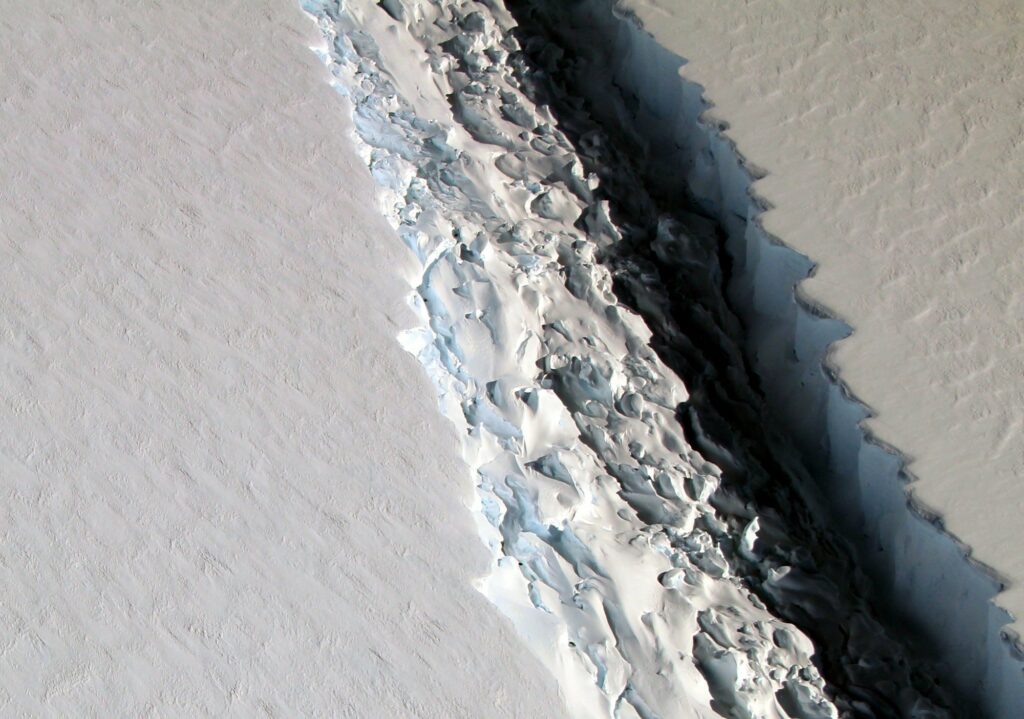
Mattia Poinelli, a research affiliate at UC Irvine has been using MITgcm to explore what role rifts and icebergs play in shaping the dynamics of Antarctic ice shelves. This month we highlight two recent publications (one published in The Cryosphere, the other in GRL) and a pair of illustrative animations.
This Month’s Featured Publications
- Mattia Poinelli, Michael Schodlok, Eric Larour, Miren Vizcaino, Riccardo Riva (2023), Can rifts alter ocean dynamics beneath ice shelves? The Cryosphere, doi: 10.5194/tc-17-2261-2023
- M. Poinelli, Y. Nakayama, E. Larour, M. Vizcaino, R. Riva (2023), Ice-Front Retreat Controls on Ocean Dynamics Under Larsen C Ice Shelf, Antarctica, Geophysical Research Letters, doi: 10.1029/2023GL104588
“We find that rifts and icebergs have profound consequences for heat delivery to ice-shelf grounding lines,” says Poinelli. “These natural features act as modulators of heat transport, primarily by serving as vorticity barriers. When rifts and icebergs are present, they obstruct the ocean flow toward the grounding line. Their presence inhibits the transport of heat, creating a localized barrier that acts as a seamount upside down. They indeed represent a sharp discontinuity in the water column thickness that acts as if the topographic barrier extended along the entire water column (Taylor–Proudman theorem). This limits the amount of off-shelf water that entrains the cavity in order to conserve potential vorticity.”
“However, the story takes a different turn when icebergs separate from the ice front, leading to ice front retreat,” Poinelli continues. “In such cases, the previously mentioned vorticity barrier is removed, and the pathway for heat to reach the grounding line becomes more accessible. This alteration can significantly impact ocean circulation beneath the ice shelves, potentially amplifying the heat delivery toward the grounding line and influencing melt in the most critical locations of the ice shelves.”
Poinelli says, “To investigate and understand these processes, we used the MITgcm, both in idealized scenarios (Poinelli in 2023a, The Cryosphere) and in regional domain simulations focusing on specific ice shelves, like Larsen C (Poinelli in 2023b, GRL) in simulations providing valuable insight into the complex interplay between rifts, icebergs, oceanic heat transport, and the stability of Antarctic ice shelves, ultimately, we hope, contributing to our understanding of ice shelves in a warming environment.”
Can rifts alter ocean dynamics beneath ice shelves? Animation showing the 2-year evolution of passive tracer tr01 distribution at the grounding line depth, 255 m. tracer tr01 is initially released in the ice shelf cavity with a value of 1. Panels a and c shows the evolution of tr01 for the SN and WE control run, respectively. In the control runs, the rift is absent. Panels b and d shows the evolution of tr01 for the SN and WE runs with a 2 km-wide rift. Intrusion of water from outside the cavity (low values of tr01), is stronger in the control runs, as the rift acts as barrier – animation courtesy Mattia Poinelli
Ice-Front Retreat Controls on Ocean Dynamics Under Larsen C Ice Shelf, Antarctica Animation showing the two-year evolution of the horizontal distribution of the passive tracer placed at the ocean surface with a value of 1 for the control (panels a-c) and iceberg (panels d-f) runs. The distribution is only shown for the first day of each month. To visualize the intrusion of this tracer (which is a proxy of High Salinity Shelf Water, HSSW) throughout the entire water column, the distribution is shown at three different depths: 200 m, 350 m, and 500 m. Intrusion of HSSW is 50% stronger in the iceberg run as the iceberg, which acted as a barrier, is removed from the model domain. As a consequence, the integrated melt rate under the ice is 73% stronger in the iceberg run – image courtesy: Mattia Poinelli
To find out more about this work, contact Mattia
Story Image: A crack in Antarctica’s Larsen C ice shelf. Image credit: NASA, John Sonntag
About the Researcher

Mattia Poinelli
Mattia Poinelli is a Specialist at the University of California, Irvine, and a Research Affiliate at Jet Propulsion Laboratory. He is interested in ice-ocean interactions in Antarctica and on icy moons. Mattia has been an MITgcm user since 2018. When not at his desk, you will probably find him surfing up and down the Southern California coast.
Other New Publications last month
Robin Baeyens et al (2023), Photodissociation and induced chemical asymmetries on ultra-hot gas giants: A case study of HCN on WASP-76 b, arXiv: 2309.00573 [astro-ph.EP]
Bendinger, A. et al (2023), Regional modeling of internal-tide dynamics around New Caledonia – Part 1: Coherent internal-tide characteristics and sea surface height signature, Ocean Sci., doi: 10.5194/os-19-1315-2023
Alma Carolina Castillo-Trujillo et al (2023), An evaluation of eight global ocean reanalyses for the Northeast U.S. continental shelf, Progress in Oceanography, doi: 10.1016/j.pocean.2023.103126
Elizabeth Ellison et al (2023), The Sensitivity of Southern Ocean Air-Sea Carbon Fluxes to Background Turbulent Diapycnal Mixing Variability, JGR Oceans, doi: 10.1029/2023JC019756
Liming Fan et al (2023), Numerical investigation of interaction between anticyclonic eddy and semidiurnal internal tide in the northeastern South China Sea, via EGUsphere, doi: 10.5194/egusphere-2023-1914
He, S. et al (2023), Modeling and prediction of large-scale climate variability by inferring causal structure, Geophysical Research Letters, doi: 10.1029/2023GL104291
Yuming Jin et al (2023), Seasonal Tropospheric Distribution and Air-sea Fluxes of Atmospheric Potential Oxygen from Global Airborne Observations, Global Biogeochemical Cycles, doi: 10.1029/2023GB007827
Zhang Kun et al (2023), Contribution of deep vertical velocity to deficiency of Sverdrup transport in the low-latitude North Pacific, Journal of Physical Oceanography, doi: 10.1175/JPO-D-23-0006.1
Jiemeihui Li et al (2023), Effects of internal solitary waves on three-dimensional sound propagation and DOA estimation in the South China Sea, Applied Acoustics, doi: 10.1016/j.apacoust.2023.109612
Qin-Ran Li et al (2023), Reconstructions of time-evolving sound-speed fields perturbed by deformed and dispersive internal solitary waves in shallow water, Chinese Physics B, doi: 10.1088/1674-1056/acf84d
Yuchen Lian et al (2023), Jupiter’s equatorial quasi-quadrennial oscillation forced by internal thermal forcing, arXiv: 2309.13953 [astro-ph.EP]
Stephanie M. Lim et al (2023), Spatial and interannual variability of Antarctic sea ice bottom algal habitat, 2004–2019, JGR Oceans, doi: 10.1029/2023JC020055
Andrew Moore et al (2023), Weak constraint 4D-Var data assimilation in the Regional Ocean Modeling System (ROMS) using a saddle-point algorithm: Application to the California Current Circulation, Ocean Modelling, doi: 10.1016/j.ocemod.2023.102262
Gemma O’Connor (2023), Investigating the Drivers of Glacier Retreat in West Antarctica Using Proxy-Data Assimilation and Numerical Modeling, University of Washington ProQuest Dissertations Publishing
Ragon, C.et al (2023), Alternative climatic steady states for the Permian-Triassic paleogeography, EGUsphere, doi: 10.5194/egusphere-2023-1808
Reese, R. et al (2023), The stability of present-day Antarctic grounding lines – Part 2: Onset of irreversible retreat of Amundsen Sea glaciers under current climate on centennial timescales cannot be excluded, The Cryosphere, doi: 10.5194/tc-17-3761-2023
Simone Silvestri et al (2023), Oceananigans.jl: A model that achieves breakthrough resolution, memory and energy efficiency in global ocean simulations, arXiv: 2309.06662 [physics.ao-ph]
Madison Smith et al (2023), Thin and transient meltwater layers and false bottoms in the Arctic sea ice pack-Recent insights on these historically overlooked features, Elementa: Science of the Anthropocene, doi: 10.1525/elementa.2023.00025
Taylor, Lindsey Michelle (2023), Linear Inverse Models for Coupled Atmosphere−Ocean Analysis and Prediction, University of Washington ProQuest Dissertations Publishing
Min Wang et al (2023), Propagation Features of Diurnal Internal Tides West of the Luzon Strait Revealed by a Large PIES Array, Journal of Physical Oceanography, doi: 10.1175/JPO-D-22-0206.1
Peidong Wang et al (2023), On the Influence of Hydroxyl Radical Changes and Ocean Sinks on Estimated HCFC and HFC Emissions and Banks, Geophysical Research Letters, doi: 10.1029/2023GL105472
Chenyue Xie et al (2023), Bathymetry-aware mesoscale eddy parameterizations across upwelling slope fronts: A machine learning-augmented approach, Journal of Physical Oceanography, doi: 10.1175/JPO-D-23-0017.1
Xi Zhang et al (2023), The Inhomogeneity Effect III: Weather Impacts on the Heat Flow of Hot Jupiters, arXiv: 2308.16165 [astro-ph.EP]
Zinck, A.-S. P. et al (2023), Unveiling spatial variability within the Dotson Melt Channel through high-resolution basal melt rates from the Reference Elevation Model of Antarctica, The Cryosphere, doi: 10.5194/tc-17-3785-2023
Do you have news about research using MITgcm? We are looking for contributions to these pages. If you have an interesting MITgcm project (ocean, atmosphere, sea-ice, physics, biology or otherwise) that you want to tell people about, get in touch. To make a post, contact Helen
